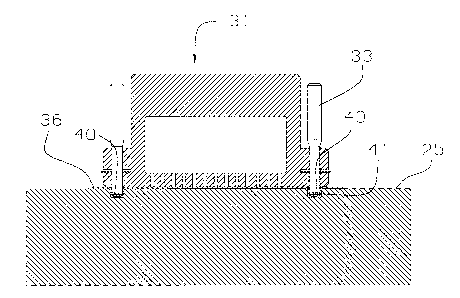Une partie des informations de ce site Web a été fournie par des sources externes. Le gouvernement du Canada n'assume aucune responsabilité concernant la précision, l'actualité ou la fiabilité des informations fournies par les sources externes. Les utilisateurs qui désirent employer cette information devraient consulter directement la source des informations. Le contenu fourni par les sources externes n'est pas assujetti aux exigences sur les langues officielles, la protection des renseignements personnels et l'accessibilité.
L'apparition de différences dans le texte et l'image des Revendications et de l'Abrégé dépend du moment auquel le document est publié. Les textes des Revendications et de l'Abrégé sont affichés :
| (12) Demande de brevet: | (11) CA 2334682 |
|---|---|
| (54) Titre français: | METHODE ET APPAREIL POUR LA FIXATION DES ETIQUETTES D'IDENTIFICATION SUR LES PRODUITS EN BOIS |
| (54) Titre anglais: | METHOD AND APPARATUS FOR FASTENING IDENTIFICATION LABELS TO WOOD PRODUCTS |
| Statut: | Retirée |
| (51) Classification internationale des brevets (CIB): |
|
|---|---|
| (72) Inventeurs : |
|
| (73) Titulaires : |
|
| (71) Demandeurs : |
|
| (74) Agent: | |
| (74) Co-agent: | |
| (45) Délivré: | |
| (22) Date de dépôt: | 2001-03-02 |
| (41) Mise à la disponibilité du public: | 2002-09-02 |
| Licence disponible: | S.O. |
| Cédé au domaine public: | S.O. |
| (25) Langue des documents déposés: | Anglais |
| Traité de coopération en matière de brevets (PCT): | Non |
|---|
| (30) Données de priorité de la demande: | S.O. |
|---|
A method and apparatus are disclosed for applying identification labels on
wooden products. A fastening system where a plastic label marked by a bar code
or other
identification method is picked up by vacuum onto the applicator tool which
will insert
forcibly edges of the identification label into the wooden product to remain
permanently
wedged in the indentation. During subsequent cutting of the wooden product
into which
is attached identification plastic label there will be no danger from
dislodged or
fragmented metal staples as is presently the case.
Another method is described where soft pliable plastic identification label is
being
picked up by the vacuum onto the applicator apparatus which is equipped with
punches
that will punch strips of hard plastic and push cut disks from the hard
plastic over the soft
pliable plastic label into the wooden product. Hard plastic disks will remain
permanently
wedged into the formed hole and secure the soft pliable plastic label to the
wooden
product. During subsequent cutting of the wood when the label is cut it will
not present
danger to the operator or the bystanders.
Note : Les revendications sont présentées dans la langue officielle dans laquelle elles ont été soumises.
Désolé, les revendications concernant le document de brevet no 2334682 sont introuvables.
Les textes ne sont pas disponibles pour tous les documents de brevet. L'étendue des dates couvertes est disponible sur la section
Actualité de l'information
.
Note : Les descriptions sont présentées dans la langue officielle dans laquelle elles ont été soumises.

2024-08-01 : Dans le cadre de la transition vers les Brevets de nouvelle génération (BNG), la base de données sur les brevets canadiens (BDBC) contient désormais un Historique d'événement plus détaillé, qui reproduit le Journal des événements de notre nouvelle solution interne.
Veuillez noter que les événements débutant par « Inactive : » se réfèrent à des événements qui ne sont plus utilisés dans notre nouvelle solution interne.
Pour une meilleure compréhension de l'état de la demande ou brevet qui figure sur cette page, la rubrique Mise en garde , et les descriptions de Brevet , Historique d'événement , Taxes périodiques et Historique des paiements devraient être consultées.
| Description | Date |
|---|---|
| Exigences pour le changement d'adresse - jugé conforme | 2002-10-15 |
| Inactive : Lettre officielle | 2002-10-15 |
| Inactive : Lettre officielle | 2002-10-15 |
| Inactive : Retirer la demande | 2002-09-12 |
| Inactive : Correspondance - Formalités | 2002-09-12 |
| Requête pour le changement d'adresse ou de mode de correspondance reçue | 2002-09-12 |
| Inactive : Retirer la demande | 2002-09-12 |
| Demande publiée (accessible au public) | 2002-09-02 |
| Inactive : Page couverture publiée | 2002-09-01 |
| Inactive : Incomplète | 2002-08-13 |
| Inactive : CIB en 1re position | 2001-03-23 |
| Inactive : Certificat de dépôt - Sans RE (Anglais) | 2001-03-09 |
| Exigences de dépôt - jugé conforme | 2001-03-09 |
| Demande reçue - nationale ordinaire | 2001-03-08 |
Il n'y a pas d'historique d'abandonnement
| Type de taxes | Anniversaire | Échéance | Date payée |
|---|---|---|---|
| Taxe pour le dépôt - petite | 2001-03-02 |
Les titulaires actuels et antérieures au dossier sont affichés en ordre alphabétique.
| Titulaires actuels au dossier |
|---|
| MIROSLAV HARCUBA |
| Titulaires antérieures au dossier |
|---|
| S.O. |